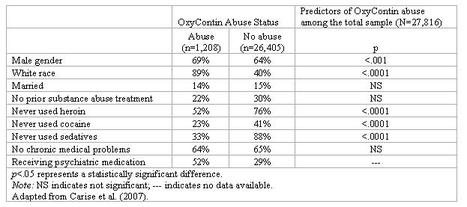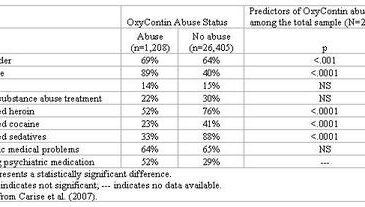OxyContin is an opioid agonist. Opioids are among the most potent analgesics; medical doctors prescribe analgesics to reduce or relieve pain (see STASH 1(2) for more information). Like other opioids (both natural and synthetic), the Drug Enforcement Agency classifies OxyContin as a Schedule II substance (Drug Enforcement Agency, 2008). Although doctors prescribe OxyContin, evidence suggests illicit use could be widespread among some populations (i.e., Davis and Johnson, 2008). This week’s BASIS reviews a study by Carise, Leggett, Dugosh, et al. (2007), which explored rates of OxyContin use among a large sample of people seeking addiction treatment. The data also provide information as to whether use was a regular function of prescribed use or, alternatively, illict and part of a pattern of persisting, multi-substance use problems.
As part of a large standardized intake interview, all admissions to 157 drug treatment programs self-reported information about their lifetime OxyContin use history (The Drug Evaluation Network System; Carise & Gruel, 2003). The researchers also gathered information about other drug use patterns, past drug treatments, and whether participants took OxyContin for medical purposes or to experience its intoxicating effects recreationally. The authors defined OxyContin abuse as having taken the drug to “get high or get a buzz,” and regular use as taking the drug more than 3 times per week for more than 1 year. Three years of assessment interviews at treatment facilities in 22 states yielded 27,816 unique participants: 1,425 (5% of the total sample) used OxyContin, 1,243 (87% of users) regularly used OxyContin, 1,208 (97% of regular users) abused OxyContin, and 300 (24% of regular users) had a prescription.

Figure. Differences between treatment seekers who did and did not abuse OxyContin. Click image to enlarge.
Table 1 indicates that abusers of OxyContin were more likely than non abusers to be male, white, and to have used heroin, cocaine, and sedatives during their lifetimes. Half of OxyContin abusers, but only 30% of non abusers, had received psychiatric medication during their lifetimes. One third of the 300 people prescribed the drug sought additional medication through illicit means, and half (150 of 300) qualified for OxyContin abuse.
The authors might have identified a larger proportion of the sample as OxyContin abusers compared to other studies because their definition of abuse (i.e., use to get high) is less conservative than the more commonly used DSM-IV-TR definition (i.e., repeated impairment, failure to meet responsibilities, or negative consequences; American Psychiatric Association, 2000). The admission interview did not ask participants which substances prompted their decision to seek treatment, so we do not know if OxyContin was the presenting problem or not. The data is based on the self-report of participants, so they might have minimized or exaggerated their reports of abuse symptom severity depending upon the perceived value such reports during treatment intake.
Carise et al. offer findings that suggest only a small portion (5%) of substance treatment seekers use OxyContin. Most patients obtained OxyContin illicitly (75%), and those with a prescription obtained additional medication illicitly (33%) or took the drug to feel intoxicated (56%). These findings suggest that with or without prescription, substance abuse treatment seekers include OxyContin as part of a larger pattern of substance abuse. To address this problem, improved systems for identification and treatment of people who abuse OxyContin is necessary to prevent illict use and unauthorized distribution.
What do you think? Please use the comment link below to provide feedback on this article.
References
American Psychiatric Association. (2000). DSM IV-TR: Diagnostic and statistical manual of mental disorders–Text revision (Fourth ed.). Washington, D.C.: American Psychiatric Association.
Carise, D., & Gurel, O. (2003). Benefits of integrating assessment technology with treatment: The Drug Evaluation Network System project. In J. Sorenson, R. A. Rawson, J. Guydish & J. Zweben (Eds.), Drug abuse treatment through collaboration: Practice and research partnerships that work (pp. 181–195). Washington, DC: American Psychological Association.
Carise, D., Leggett Dugosh, K., McLellan, A. T., Camilleri, A., Woody, G. E., & Lynch, K. G. (2007). Prescription OxyContin abuse among patients entering addiction treatment. American Journal of Psychiatry, 164, 1750–1756.
Davis, W.R., Johnson, B.D. (2008). Prescription opoid use, misuse, and diversion among street drug users in New York City. Drug and Alcohol Dependence, 92(1-3), 267-276.




